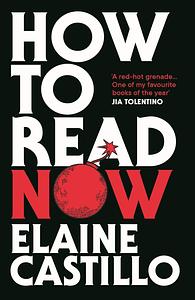Take a photo of a barcode or cover
challenging
informative
medium-paced
How to Read Now is not for the faint of heart. Castillo wants to go beyond the old adage that reading helps build empathy and creates for diversified points of view. No, reading is much more than that. Reading is a chance for the reader to deconstruct the raw history of the time and place of not only the characters but the cultural context in which the book was written, the goals and the oversights of the reader and the publisher and the community surrounding the book. How to Read Now will push you to think even more critically about yourself and your reading habits.
It's an eye-opening reading that's best taken one chapter at a time. It's easy to fall into the hellhole that is reality when looking at our modern texts from a different point of view, but don't be troubled. If you've learned something new here, you're already becoming a better reader.
It's an eye-opening reading that's best taken one chapter at a time. It's easy to fall into the hellhole that is reality when looking at our modern texts from a different point of view, but don't be troubled. If you've learned something new here, you're already becoming a better reader.
challenging
funny
informative
reflective
fast-paced
I don’t know that I can express in words how important it is that this book found me at this specific time. Castillo’s essays engage with the publishing industry, the painful history of settler colonialism, and how to navigate through the world in the most media literate way possible. Castillo is also funny as hell and so incredibly earnest. I loved this book so much. Could very well be one of my favorite books of 2025.
If you’ve ever found yourself saying, “reading fiction builds empathy” or “positive representation,” you need to pick up this book.
If you’ve ever found yourself saying, “reading fiction builds empathy” or “positive representation,” you need to pick up this book.
challenging
funny
reflective
medium-paced
How to Read Now has been on my TBR since it was published in 2022. This year, I’ve been on a mission to sharpen my critical reading skills, so I finally picked it up. Alas, this book is not what I had naively expected — my brain ignored the “essays” part of the title in favor of the “how to” part — but it is, without a doubt, excellent.
Written with more than a dash of spunk, personality, and sarcasm, How to Read Now is a collection of whip-smart essays on the current state of the politics of reading. Castillo draws from a lifetime of deep, wide, critical reading to call out all the BS: the impossibility of nonpolitical art, the empty allyship of “reading for empathy,” the false promises of the publishing industry’s box-checking, the hypocrisy of calls to “separate the art from the artist” for white authors while BIPOC authors cannot have their work evaluated separately from their identities, and so much more.
What will stick with me longest, I think, is Castillo’s construction of the “unexpected reader,” ie the person an author never would have or could have expected to read their work. For example, Hemingway never would have expected someone like, say, a Black trans woman from New York City. However, white readers have never lived in a world where they were not the expected readers of literally everything. And so when they find themselves to be the unexpected reader, they criticize (or vilify) the author for it.
I can’t wait to inhale whatever Castillo puts out next.
Graphic: Death of parent
Moderate: Racism, Xenophobia, Colonisation
challenging
emotional
funny
informative
inspiring
reflective
medium-paced
funny
informative
funny
informative
inspiring
medium-paced
challenging
dark
informative
reflective
medium-paced







